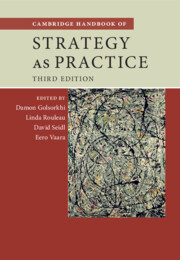Book contents
- Cambridge Handbook of Strategy as Practice
- Cambridge Handbook of Strategy as Practice
- Copyright page
- Contents
- Figures
- Tables
- Boxes
- Contributors
- Preface to the Third Edition
- Introduction: What Is Strategy as Practice?
- Part I Ontological and Epistemological Questions
- Part II Theoretical Resources: Social Theory
- Part III Theoretical Resources: Organization and Management Theories
- Part IV Methodological Resources
- Part V Substantive Topic Areas
- Index
- References
Part V - Substantive Topic Areas
Published online by Cambridge University Press: 11 March 2025
- Cambridge Handbook of Strategy as Practice
- Cambridge Handbook of Strategy as Practice
- Copyright page
- Contents
- Figures
- Tables
- Boxes
- Contributors
- Preface to the Third Edition
- Introduction: What Is Strategy as Practice?
- Part I Ontological and Epistemological Questions
- Part II Theoretical Resources: Social Theory
- Part III Theoretical Resources: Organization and Management Theories
- Part IV Methodological Resources
- Part V Substantive Topic Areas
- Index
- References
- Type
- Chapter
- Information
- Cambridge Handbook of Strategy as Practice , pp. 599 - 788Publisher: Cambridge University PressPrint publication year: 2025
References
References
Acknowledgement
We thank the Swiss National Science Foundation for having funded this research project (SNF number: 100014_130338).
References
References
References
Acknowledgements
We gratefully acknowledge the financial support of this project through a grant from the Austrian Science Fund (FWF): P35868-G ‘Open Strategy: A Micro-level Perspective on Psychological Antecedents and Implementation Consequences’.

